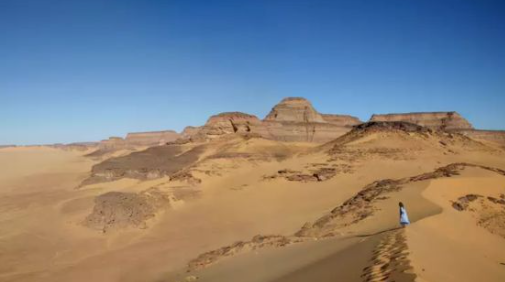
The Sahara Desert, now dry and sandy, was once filled with lakes and green grasslands. Remains found in rock caves show ancient people lived here with their animals. “Old lake layers, plant pollen, and tools prove people hunted, raised animals, and collected food in this now-empty area,” says Dr. Nada Salem from the Max Planck Institute.
1.1. What did scientists find to prove ancient humans lived in the Sahara?
A Modern cities under the sand.
B Old tools and plant remains.
C Maps drawn on animal skins.
D Stories from local people.
解析:选B。B 细节理解题。根据第一段的“Old lake layers, plant pollen, and tools”可知,科学家通过古老的湖床层、植物花粉和工具证明人类活动。故选B。
2.2. What does the DNA study tell us about North Africans 7,000 years ago?
A They moved to Europe frequently.
B They ate only plants and fruits.
C They built many large caves.
D They shared genes with Moroccans.
解析:选D。D 推理判断题。第二段指出利比亚女性的DNA与15,000年前的摩洛哥人“closely matched”(高度匹配),由此可知,他们拥有相似的基因。故选D。
3.3. What does “natural walls” mean in the text?
A Big houses made of stone.
B Things like rivers and hills.
C Rules made by ancient leaders.
D Walls between different countries.
解析:选B。B 词意指代题。第三段中“natural walls”前文明确解释为“different environments—like wetlands and mountains”(湿地和山脉等不同环境),选项B的“rivers and hills”(河流和山丘)是同类地理特征的简化表达。故选B。
4.4. Why is studying the Sahara’s past important?
A To explore the history of the Sahara Desert itself.
B To analyze ancient human DNA for medical research.
C To learn how humans lived in bad natural conditions.
D To prove that cultural changes are unrelated to survival methods.
解析:选C。C 推理判断题。根据最后一段中的“This important study shows how humans adapted to extreme environments”“By studying old DNA and objects, scientists keep discovering how humans survived in Earth’s toughest places.”可知,通过研究撒哈拉的过去,科学家们不断发现人类是如何在地球上最恶劣的自然环境中生存下来的。故选C。